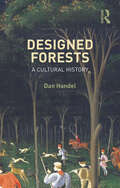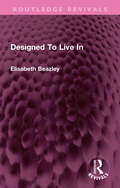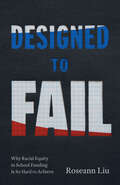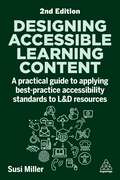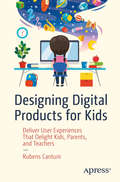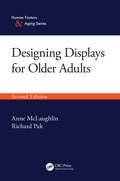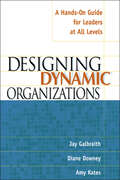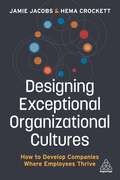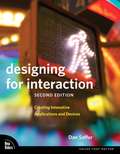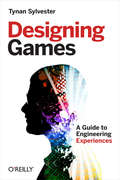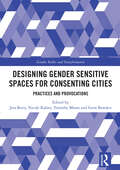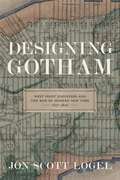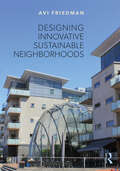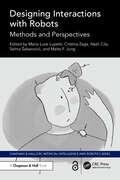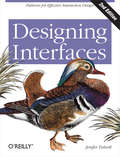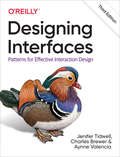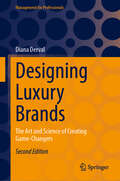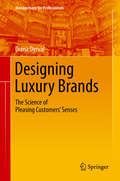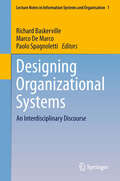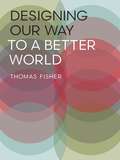- Table View
- List View
Design/Repair: Place, Practice & Community
by Alison Gill Eleni Kalantidou Guy Keulemans Abby Mellick Lopes Niklavs RubenisThis collection of essays sheds light on repair as a disposition to material culture and a practice rooted in diverse sociocultural experiences. It provides an in-depth exploration of how repair manifests itself through the different lenses of governance, grassroots activism, transformative design and community-led initiatives. Most importantly, the chapters demonstrate how place-based approaches can reveal blueprints for social impact in circumstances of growing environmental and social precariousness.
Designed Forests: A Cultural History
by Dan HandelDesigned Forests: A Cultural History explores the unique kinship that exists between forests and spatial design; the forest’s influence on architectural culture and practice; and the potentials and pitfalls of “forest thinking” for more sustainable and ethical ways of doing architecture today. It tackles these subjects by focusing on architecture’s own dispositions, which stem from an ecology of metaphor that surrounds its encounters with the forest and undergird ideas about Nature and natural systems. The book weaves together global narratives and chapters explore a range of topics, such as the invention of forest plans in colonial India, the war waged on the jungles of Vietnam, economic land use concepts in rural Germany, precolonial ecological pasts in Manhattan, and technologically saturated forests in California. This book is essential for landscape architects, urbanists, architects, forestry experts, and everyone concerned with larger environmental contexts and the ever-evolving relationship between nature and culture.
Designed To Live In (Routledge Revivals)
by Elisabeth BeazleyOriginally published in 1962, this book traces the main influences behind modern design in domestic architecture. It does so against the context of the effect each new dwelling has on its environment and the effect its design has on those in the surrounding (and often older, historic) housing stock. Diverse influences such as the bye-law street and Le Corbusier’s Ville Radieuse are discussed, while the ideas bearing on the individual private house range from those of the early nineteenth century villa builders to Frank Lloyd Wright’s prairie houses and the work of Mies van der Rohe. The book closes with a detailed discussion of the problems and possibilities of domestic design in house-building in the late 20th Century
Designed to Fail: Why Racial Equity in School Funding Is So Hard to Achieve
by Roseann LiuA provocative examination of how systemic racism in education funding is sustained. For people who care about urban school districts like Philadelphia’s, addressing the challenges that these schools face often boils down to the need for more money. But why are urban districts that serve Black and Brown students still so perennially underfunded compared to majority-white ones? Why is racial equity in school funding so hard to achieve? In Designed to Fail, Roseann Liu provides an inside look at the Pennsylvania state legislature and campaigns for fair funding to show how those responsible for the distribution of school funding work to maintain the privileges of majority-white school districts. Liu analyzes how colorblind policies, political structures, and the maintenance of the status quo by people in power perpetuate wide and deepening racial disparities in education funding. Taking a lesson from community organizers fighting for a racially equitable school funding system, Liu’s work is a bold call to address structural racism at the root and organize from a place of abundant justice.
Designing Accessible Learning Content: A Practical Guide to Applying best-practice Accessibility Standards to L&D Resources
by Susi MillerMaking learning and development (L&D) content inclusive and accessible for everyone is not only a good thing to do, it's the right thing to do.Designing Accessible Learning Content is a practical guide on accessibility for anyone involved in the design, creation, development or testing of online learning content. Now updated to include detailed guidelines on the Web Content Accessibility Guidelines and the nine new standards, this book provides HR and OD professionals and academics with evidence-based advice on designing inclusive digital learning content.Featuring real-world examples from industry-leading brands, this book demonstrates how accessible learning content can improve usability and provide the best possible learning experience for all. It is an essential handbook for all L&D professionals seeking to harness the benefits of accessibility in order to improve their learning content for everyone.
Designing Clothes: Culture and Organization of the Fashion Industry
by Veronica ManlowFashion is all around us: we see it, we buy it, we read about it, but most people know little about fashion as a business. Veronica Manlow considers the broader signifi cance of fashion in society, the creative process of fashion design, and how fashion unfolds in an organizational context where design is conceived and executed. To get a true insider's perspective, she became an intern at fashion giant Tommy Hilfi ger. Th ere, she observed and recorded how a business's culture is built on a brand that is linked to the charisma and style of its leader. Fashion firms are not just in the business of selling clothing along with a variety of sidelines. Th ese companies must also sell a larger concept around which people can identify and distinguish themselves from others. Manlow defi nes the four main tasks of a fashion fi rm as creation of an image, translation of that image into a product, presentation of the product, and selling the product. Each of these processes is interrelated and each requires the eff orts of a variety of specialists, who are often in distant locations. Manlow shows how the design and presentation of fashion is infl uenced by changes in society, both cultural and economic. Information about past sales and reception of items, as well as projective research informs design, manufacturing, sales, distribution, and marketing decisions. Manlow offers a comprehensive view of the ways in which creative decisions are made, leading up to the creation of actual styles. She helps to defi ne the contribution fashion fi rms make in upholding, challenging, or redefi ning the social order. Readers will fi nd this a fascinating examination of an industry that is quite visible, but little understood.
Designing Digital Products for Kids: Deliver User Experiences That Delight Kids, Parents, and Teachers
by Rubens CantuniChildhood learning is now more screen-based than ever before, and app developers are flocking in droves to this lucrative and exciting market. The younger generation deserves the best, and growing up in a digital world has made them discerning and demanding customers. Creating a valuable user experience for a child is as complex and involved as when designing a typical app for an adult, if not more, and Designing Digital Products for Kids is here to be your guide. Author and designer Rubens Cantuni recognizes the societal importance of a high-quality and ethical app experience for children. There is room for significant improvement in this space, and Cantuni helps you optimize it. Designing Digital Products for Kids walks hopeful developers through digital product design—including research, concept, design, release, marketing, testing, analyzing, and iterating—all while aiming to build specifically for children. Industry experts and their real-world advice are showcased in this book, along with careful advice for the ethics that go along with this unique market. These tips include complex needs regarding mental development, accessibility, conscious screen time limits, and content sensitivity. Children, parents, and teachers alike are hungry for more thoughtful players in the kids’ app space, and Designing Digital Products for Kids is your ticket to successfully developing and educating for the future. What You Will LearnDesign platforms specifically for children, to entertain and educate themWork with a complex audience of parents, teachers and kidsUnderstand how different monetization strategies work in this industry and why Who This Book Is ForUser experience designers, UI designers, product owners, teachers and educators, startup founders. The range of topics is so wide that anyone interested or involved in digital products could find something interesting to learn.
Designing Displays for Older Adults, Second Edition
by Anne McLaughlin Richard PakThis book focuses on the design of displays and user interfaces for the older user. Aging is related to complex mental, physical, and social changes. While conventional wisdom says getting older leads to a decline, the reality is that some capabilities decline with age while others remain stable or increase. This book distills decades of aging research into practical advice on the design of displays. Technology has changed dramatically since the publication of the first edition. This new edition covers cutting-edge technology design such as ubiquitous touchscreens, smart speakers, and augmented reality interfaces, among others.
Designing Dynamic Organizations: A Hands-on Guide for Leaders at All Levels
by Amy Kates Jay Galbraith Diane DowneyWhich business structures are best suited to the unpredictable 21st century? How can a business reconfigure itself with minimum disruption and maximum impact?Every executive grapples with problems of restructuring--and most need hands-on guidance to solve them. Based on Jay Galbraith&’s world-renowned approach to organization design and featuring a broad selection of practical tips and tools developed by Diane Downey and Amy Kates, Designing Dynamic Organizations gives business leaders at all levels everything they need to implement positive, progressive change.In this book, business executives will learn how to examine their choices by leading them systematically through these fundamental questions:Should we restructure to meet our strategic goals?What are the best structural options to achieve our success?What lateral processes are necessary to support the new structure?How do we staff the restructured organization to optimize results?Designing Dynamic Organizations includes examples and worksheets that pilot you through the essential steps of organizational design.
Designing Exceptional Organizational Cultures: How to Develop Companies where Employees Thrive
by Jamie Jacobs Hema CrockettDesigning Exceptional Organizational Cultures is a practical guide for HR and OD professionals which explains how to proactively design, build and foster a culture that creates employee and business success. For a company to outperform the competition and achieve sustainable business growth, it needs a high performing, engaged and committed workforce with the skills the business needs both now and in the future. Attracting, motivating and retaining top talent can't be done simply by attaching individual benefits to specific job roles. To be effective, companies need to build an exceptional company culture where people want to work and that allows them to develop and perform to their full potential. Designing Exceptional Organizational Cultures provides guidance on all elements of building a top performing culture including how to identify and define core company values and embed them throughout policies, processes and behaviours as well as how to create an organizational structure that leverages employees' strengths for optimum performance. It also covers how to assess what roles the business needs, how to recruit for future success and make the most of non-traditional hires as well as covering employee engagement, motivation, reward, diversity and Learning and Development (L&D). With practical examples, tips and advice throughout , this is crucial reading for anyone needing to build a culture that attracts the very best talent and achieve sustainable business growth.
Designing For Interaction: Creating Innovative Applications and Devices
by Dan SafferBuilding products and services that people interact with is the big challenge of the 21st century. Dan Saffer has done an amazing job synthesizing the chaos into an understandable, ordered reference that is a bookshelf must-have for anyone thinking of creating new designs. " -- Jared Spool, CEO of User Interface Engineering Interaction design is all around us. If you've ever wondered why your mobile phone looks pretty but doesn't work well, you've confronted bad interaction design. But if you've ever marveled at the joy of using an iPhone, shared your photos on Flickr, used an ATM machine, recorded a television show on TiVo, or ordered a movie off Netflix, you've encountered good interaction design: products that work as well as they look. Interaction design is the new field that defines how our interactive products behave. Between the technology that powers our devices and the visual and industrial design that creates the products' aesthetics lies the practice that figures out how to make our products useful, usable, and desirable. This thought-provoking new edition of Designing for Interaction offers the perspective of one of the most respected experts in the field, Dan Saffer. This book will help you learn to create a design strategy that differentiates your product from the competition use design research to uncover people's behaviors, motivations, and goals in order to design for them employ brainstorming best practices to create innovativenew products and solutions understand the process and methods used to define product behavior It also offers interviews and case studies from industry leaders on prototyping, designing in an Agile environment, service design, ubicomp, robots, and more.
Designing Games: A Guide to Engineering Experiences
by Tynan SylvesterReady to give your design skills a real boost? This eye-opening book helps you explore the design structure behind most of todayâ??s hit video games. Youâ??ll learn principles and practices for crafting games that generate emotionally charged experiencesâ??a combination of elegant game mechanics, compelling fiction, and pace that fully immerses players.In clear and approachable prose, design pro Tynan Sylvester also looks at the day-to-day process necessary to keep your project on track, including how to work with a team, and how to avoid creative dead ends. Packed with examples, this book will change your perception of game design.Create game mechanics to trigger a range of emotions and provide a variety of playExplore several options for combining narrative with interactivityBuild interactions that let multiplayer gamers get into each otherâ??s headsMotivate players through rewards that align with the rest of the gameEstablish a metaphor vocabulary to help players learn which design aspects are game mechanicsPlan, test, and analyze your design through iteration rather than deciding everything up frontLearn how your gameâ??s market positioning will affect your design
Designing Gender Sensitive Spaces for Consenting Cities: Practices and Provocations (Gender, Bodies and Transformation)
by Jess Berry Nicole Kalms Timothy Moore Gene BawdenThis edited collection investigates gender-sensitive spaces, design practices, and provocations that challenge the complex social and material structures that shape inequities of access and inclusion in the urban environment.Designing Gender Sensitive Spaces for Consenting Cities: Practices and Provocations centres intersectional, gender-sensitive approaches to design in the urban environment as an integral strategy in combating spatial inequities. Through an investigation of design-led methods, project case studies, activist interventions, and processes of resistance and agency, this volume offers new thinking and practical approaches to demonstrate how design might shift towards safer and more inclusive cities for women, gender-diverse people, and LGBTIQ+ communities.This book will appeal to practitioners, scholars, and students of urbanism, design, planning, architecture, and geography, as well as government and non-profit organisations that are interested in gender and equality and can influence the future narratives of cities.
Designing Gotham: West Point Engineers and the Rise of Modern New York, 1817-1898 (Conflicting Worlds: New Dimensions of the American Civil War)
by Jon Scott LogelBetween 1817 and 1898, New York City evolved from a vital Atlantic port of trade to the center of American commerce and culture. With this rapid commercial growth and cultural development, New York came to epitomize a nineteenth-century metropolis. Although this important urban transformation is well documented, the critical role of select Union soldiers turned New York engineers has, until now, remained largely unexplored. In Designing Gotham, Jon Scott Logel examines the fascinating careers of George S. Greene, Egbert L. Viele, John Newton, Henry Warner Slocum, and Fitz John Porter, all of whom studied engineering at West Point, served in the United States Army during the Civil War, and later advanced their civilian careers and status through the creation of Victorian New York.These influential cadets trained at West Point in the nation’s first engineering school, a program designed by Sylvanus Thayer and Dennis Hart Mahan that would shape civil engineering in New York and beyond. After the war, these industrious professionals leveraged their education and military experience to wield significant influence during New York’s social, economic, and political transformation. Logel examines how each engineer’s Civil War service shaped his contributions to postwar activities in the city, including the construction of the Croton Aqueduct, the creation of Central Park, and the building of the Brooklyn Bridge. Logel also delves into the administration of New York’s municipal departments, in which Military Academy alumni interacted with New York elites, politicians, and civilian-trained engineers. Examining the West Pointers’ experiences—as cadets, military officers during the war, and New Yorkers—Logel assesses how these men impacted the growing metropolis, the rise of professionalization, and the advent of Progressivism at the end of the century.
Designing Green Spaces for Health: Using Plants to Reduce the Spread of Airborne Viruses
by Stevie FamulariThis book focuses on using plants in spatial design to reduce the infectiousness of viruses in different working and living spaces. It presents strategies for interior and exterior green designs with plants that are likely effective for flu virus tolerance and reduction of infectiousness. The designs are appealing for interaction and healing, as well as focusing on the reduction and removal of virus infectiousness. The Famulari Theory requires examining plants that are likely effective for virus accumulation based on their leaves with stomata, trichomes, and dense leaf growth, and transpiration rate accumulation of airborne viruses. In addition, this research requires reviewing the quantity and specific types of plants (as well as electronic sources, such as humidifiers and water features) needed to produce effective humidity for plants to decrease the infectiousness or transmission of viruses; the effective distance of people to plants; and light, water, soil, and temperature needs. The book addresses the various greening practices that can be applied to sites to reduce the infectiousness of the airborne flu virus – especially in areas such as train stations, restaurants, rooftops, courtyards, office buildings and work spaces/conference rooms, and the home office – and the ways that businesses owners and residents can integrate these practices to reduce the air contaminants with a green solution. Designing green spaces that accumulate, reduce, and remove the infectiousness of viruses involves exploring multiple approaches from different directions to achieve the most effective and ideal design. The six basic approaches include 1. Temperature minimum of 70° Fahrenheit 2. Plants with multiple stomata on the leaf surfaces 3. Plants with multiple clumps of dense leaves with a high transpiration rate 4. Plants with rough leaf surfaces or with trichomes (plant hairs) on the leaf 5. Relative humidity (RH) minimum of 43% or higher 6. Air circulation to direct air with the airborne flu virus to the planted areas Stevie Famulari brings unique insights and inspires the development of green understanding and design solution plans with both short-term and long-term approaches. Illustrations of greening applied to locations help you understand your own design solutions to create them in your site. This book breaks down the misconceptions of the complexity of sustainability and green practices and provides illustrations and site-appropriate green solutions that you can incorporate into your lifestyle for a healthier site. Greening is a lifestyle change, and this guide lets you know how easy it is to transition to the green side to improve your health.
Designing Innovative Sustainable Neighborhoods
by Avi FriedmanThis book covers fundamental aspects of neighborhood planning and architecture along sustainable principles. Written by a designer and instructor, the book’s fully illustrated chapters provide detailed insights into contemporary strategies that architects, planners and builders are integrating into their thought processes and residential design practices. Past approaches to planning and design modes of dwellings and neighborhoods can no longer sustain new demands and require innovative thinking. This book explores new outlooks on neighborhood design, which are propelled by fundamental changes that touch upon environmental, economic and social aspects. It presents contemporary well-designed and illustrated examples of communities and detailed analysis of topics including the depletion of non-renewable natural resources, elevated levels of greenhouse gas emissions and climate change. It also explores the increasing costs of material, labor, land and infrastructure, which pose economic challenges; as well as social challenges including the need for walkable communities and the increase in live-work environments. The need to think innovatively about neighborhoods is at the core of this book, which will be useful to students and practitioners of urban design, urban planning, geography and urban systems; and to architecture studios focused on sustainable residential development.
Designing Integrated Care Ecosystems: A Socio-Technical Perspective
by Bernard J. Mohr Ezra DessersThis book brings together research and theory about integrated care ecosystems with modern Socio-Technical Systems Design. It provides a practical framework for collaborative action and the potential for better care in every sense. By combining the aspirations, information, resources, activities, and the skills of public and private organizations, independent care providers, informal care givers, patients and other ecosystem actors, this framework makes possible results that none of the parties concerned can achieve independently It is both a design challenge and a call for innovation in how we think about health care co-creation. Illustrative stories from many countries highlight different aspects of integrated care ecosystems, their design and their functioning in ways that allow us to push the operating frontiers of what we today call our health care system. It explains what it means to design higher levels of coordination and collaboration into fragmented care ecosystems and explores who the participants should and can be in that process. Written for a broad audience including researchers, professionals, and policy makers, this book offers readers new thinking about what outcomes are possible and ways to achieve them.
Designing Interactions with Robots: Methods and Perspectives (Chapman & Hall/CRC Artificial Intelligence and Robotics Series)
by Maria Luce Lupetti Cristina Zaga Nazli Cila Selma Šabanović Malte F. JungDeveloping robots to interact with humans is a complex interdisciplinary effort. While engineering and social science perspectives on designing human–robot interactions (HRI) are readily available, the body of knowledge and practices related to design, specifically interaction design, often remain tacit. Designing Interactions with Robots fills an important resource gap in the HRI community, and acts as a guide to navigating design-specific methods, tools, and techniques.With contributions from the field's leading experts and rising pioneers, this collection presents state of the art knowledge and a range of design methods, tools, and techniques, which cover the various phases of an HRI project. This book is accessible to an interdisciplinary audience, and does not assume any design knowledge. It provides actionable resources whose efficacy have been tested and proven in existing research.This manual is essential for HRI design students, researchers, and practitioners alike. It offers crucial guidance for the processes involved in robot and HRI design, marking a significant stride toward advancing the HRI landscape.The Open Access version of this book, available at http://www.taylorfrancis.com, has been made available under a Creative Commons Attribution-Non Commercial-No Derivatives (CC-BY-NC-ND) 4.0 license.
Designing Interfaces
by Jenifer TidwellThis idea book describes 94 user interface design components for both desktop and web applications. Separate chapters address content structure, navigation, page layout, actions and commands, information graphics, and data collection forms. Most of the patterns receive a two-page layout that explains when, how, and why to use the technique and provides example screenshots in color. Annotation ©2006 Book News, Inc. , Portland, OR (booknews. com)
Designing Interfaces
by Jenifer TidwellDespite all of the UI toolkits available today, it's still not easy to design good application interfaces. This bestselling book is one of the few reliable sources to help you navigate through the maze of design options. By capturing UI best practices and reusable ideas as design patterns, Designing Interfaces provides solutions to common design problems that you can tailor to the situation at hand. This updated edition includes patterns for mobile apps and social media, as well as web applications and desktop software. Each pattern contains full-color examples and practical design advice that you can use immediately. Experienced designers can use this guide as a sourcebook of ideas; novices will find a roadmap to the world of interface and interaction design. Design engaging and usable interfaces with more confidence and less guesswork Learn design concepts that are often misunderstood, such as affordances, visual hierarchy, navigational distance, and the use of color Get recommendations for specific UI patterns, including alternatives and warnings on when not to use them Mix and recombine UI ideas as you see fit Polish the look and feel of your interfaces with graphic design principles and patterns "Anyone who's serious about designing interfaces should have this book on their shelf for reference. It's the most comprehensive cross-platform examination of common interface patterns anywhere." --Dan Saffer, author of Designing Gestural Interfaces (O'Reilly) and Designing for Interaction (New Riders)
Designing Interfaces: Patterns for Effective Interaction Design
by Jenifer Tidwell Charles Brewer Aynne ValenciaDesigning good application interfaces isn’t easy now that companies need to create compelling, seamless user experiences across an exploding number of channels, screens, and contexts. In this updated third edition, you’ll learn how to navigate through the maze of design options. By capturing UI best practices as design patterns, this best-selling book provides solutions to common design problems.You’ll learn patterns for mobile apps, web applications, and desktop software. Each pattern contains full-color examples and practical design advice you can apply immediately. Experienced designers can use this guide as an idea sourcebook, and novices will find a road map to the world of interface and interaction design.Understand your users before you start designingBuild your software’s structure so it makes sense to usersDesign components to help users complete tasks on any deviceLearn how to promote wayfinding in your softwarePlace elements to guide users to information and functionsLearn how visual design can make or break product usabilityDisplay complex data with artful visualizations
Designing Luxury Brands: The Art and Science of Creating Game-Changers (Management for Professionals)
by Diana DervalThis book, a second offering after the successful first edition, shows how to build successful luxury brands using the power of sensory science and neuropsychology. The author presents inspiring business cases like Tesla Cybertruck, Chanel, KaDeWe, Baccarat, JACQUEMUS, NASA, MUD Jeans, Lilium, Rémy Cointreau, FENG J, Moncler, Louboutin, or Raffles Dubai in industries such as Fashion, Automotive or Leisure. The book highlights groundbreaking scientific methods - like the Derval Color Test® taken by over 30 million people - to help predict luxury shoppers’ preferences and purchasing patterns. Game-changing and unique features of successful luxury brands are decoded. Through various practical examples and experiments, readers will be able to build, revamp, or expand luxury brands and look at luxury from a new angle.
Designing Luxury Brands: The Science Of Pleasing Customers' Senses (Management For Professionals)
by Diana DervalThis book shows how to build successful luxury brands using the power of sensory science and neuro-physiology. The author introduces – based on inspiring business cases like Tesla, Louis Vuitton, Chanel, Hermès, Moncler, Louboutin, or Sofitel in industries such as Fashion, Automotive or Leisure – groundbreaking scientific methods - like the Derval Color Test® taken by over 10 million people - to predict luxury shoppers’ preferences and purchasing patterns and illustrates common and unique features of successful luxury brands. Through various practical examples and experiments, readers will be able to build, revamp, or expand luxury brands and look at luxury from a new angle.
Designing Organizational Systems
by Paolo Spagnoletti Marco De Marco Richard BaskervilleThis book is dedicated to the memory of Professor Alessandro (Sandro) D'Atri, who passed away in April 2011. Professor D'Atri started his career as a brilliant scholar interested in theoretical computer science, databases and, more generally information processing systems. He journeyed far in various applications, such as human-computer interaction, human factors, ultimately arriving at business information systems and business organisation after more than 20 years of researc hbased on "problem solving". Professor D'Atri pursued the development of an interdisciplinary culture in which social sciences, systems design and human sciences are mutually integrated. Rather than retrospection, this book is aimed to advance in these directions and to stimulate a debate about the potential of design research in the field of information systems and organisation studies with an interdisciplinary approach. Each chapter has been selected by the Editorial Board following a double blind peer review process. The general criteria of privileging the variety of topics and the design science orientation and/or empirical works in which a design research approach is adopted to solve various field problems in the management area. In addition several chapters contribute to the meta-discourse on design science research.
Designing Our Way to a Better World
by Thomas FisherEnvisioning what we need, when it doesn't yet exist: this, Thomas Fisher tells us, is what design does. And if what we need now is a better world--functioning schools, working infrastructure, thriving cities--why not design one? Fisher shows how the principles of design apply to services and systems that seem to evolve naturally, systems whose failures sometimes seem as arbitrary and inevitable as the weather. But the "invisible" systems we depend on for our daily lives (in education, politics, economics, and public health) are designed every bit as much as the products we buy and the environments we inhabit--and are just as susceptible to creative reimagining.Designing Our Way to a Better World challenges the assumptions that have led to so much poor performance in the public and private realms: that our schools cannot teach creativity, that our governments cannot predict the disasters that befall us, that our health system will protect us from pandemics, that our politics will remain polarized, that our economy cannot avoid inequality, and that our industry cannot help but pollute the environment. Targeting these assumptions, Fisher's approach reveals the power of design to synthesize our knowledge about the world into greater wholes. In doing so, this book opens up possible futures--and better futures--than the unsustainable and inequitable one we now face.

